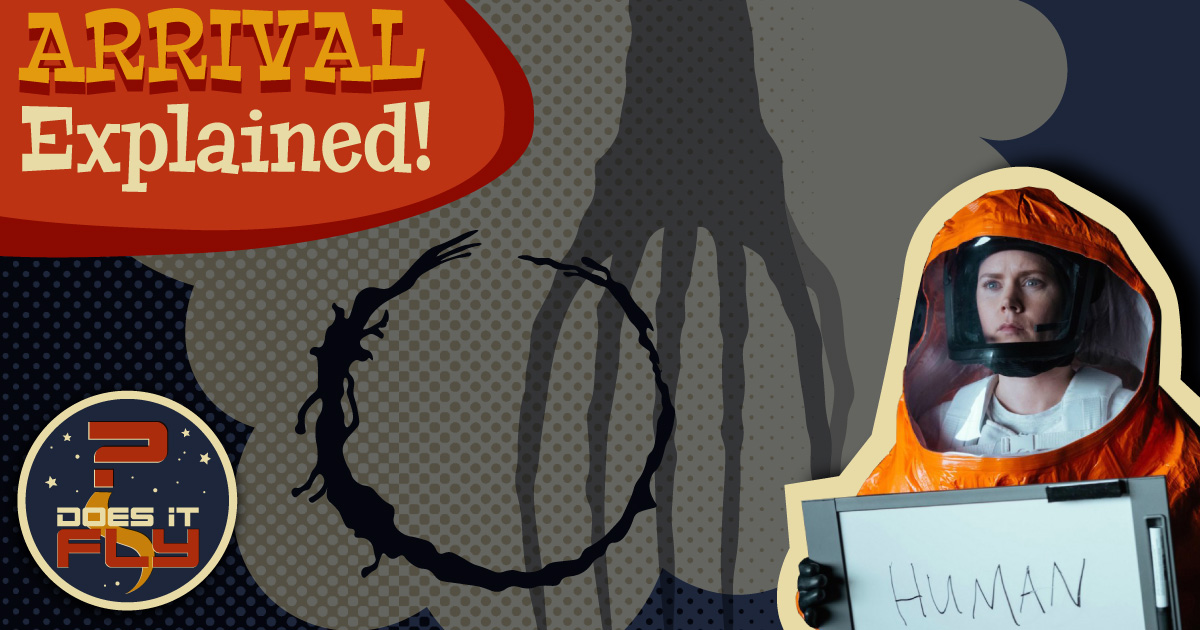Arrival Explained! Breaking Down a Classic Sci-Fi Movie
How does language actually affect our perception of the world around us? And does the brilliant science fiction movie Arrival actually have basis in science and philosophy?
“Incomprehensible guttural noises”
- The Heptapods
Arrival is as difficult a movie to discuss in the limited space of our show notes as it is a truly great work of modern science fiction filmmaking. It’s also virtually impossible to discuss without spoilers. Heck, we had trouble cramming our discussion of the central concepts of the film into One of director Denis Villeneuve’s crowning cinematic achievements (and almost certainly the thing that made us all realize that he might be the only director who would be able to get Dune right on screen), Arrival is an alien invasion movie unlike any other, one in which the humans don’t cope with our new and strange looking neighbors with aggression, but rather by using science and reasoning to understand and communicate with them. Imagine that!
You might fancy yourself a wiseacre and suggest the very notion of science and reasoning “does not fly” given the state of the world these days, but let’s set that cynicism aside for the moment and get at the heart of this week’s topic. Because in order to understand the way these aliens (the heptapods, not to be confused with Hakeem’s ongoing Planet of the Cephalopods pitch) communicate via bizarre and smoky glyphs, humans are able to change their perception of time itself. You’ve heard of “perception determines reality” so get ready for “language affects perception which thus helps determine reality.” And if that sounds confusing, don’t worry, because you’ve got Dr. Hakeem Oluseyi and Tamara Krinsky to hold your smoky hand (limb?) and walk you through it (forwards, backwards, and perhaps both at once).
All of this and more is explored on a special, extra-sized episode of Does it Fly?…
SUGGESTED VIEWING
You mean you haven’t seen Arrival? And you’re watching and/or listening to this show? What’s wrong with you! Go watch one of the most beautiful sci-fi movies of the last 25 years and THEN come back and hang out with us.
FURTHER READING
Do you want to delve a little deeper into the facts, concepts, and stories Hakeem and Tamara referenced in today’s episode? Of course you do!
Story of Your Life
Arrival is based on a short story by Ted Chiang, called “Story of Your Life” which won the 1999 Hugo Award for Best Novella. It’s available in a collection of Chiang’s short stories, Stories of
Your Life and Others.
Relativity in Arrival
Also known as the Sapir-Worf Hypothesis, based on the work of Edward Sapir and Benjamin Lee Whorf, but actually first stated as such Harry Hoijer in 1954. To quote Hoijer (via the Stanford Encyclopedia of Philosophy who have the most comprehensive explanation of this that we’ve been able to find): “language functions, not simply as a device for reporting experience, but also, and more significantly, as a way of defining experience for its speakers.”
Arrival takes that to the next level by showing how it could define how we experience time itself! It also incorporates elements of the Many-Worlds theory, which we discussed in our Back to the Future episode!
For extra credit, read up on Presentism, which postulates that only the current moment we live in is actual existence vs Eternalism, which states that our past AND future are equally real at all times. Then go take an Advil or something.
The End of Time
No, we’re not talking about whatever horrors have you doomscrolling at the moment. It’s Julian Barbour’s book The End of Time: The Next Revolution in Our Understanding of the Universe, which argues that time as we know/perceive it, isn’t really a thing.
Speaking of time being an illusion…
Psilocybin
We aren’t endorsing anything, but…
WANT MORE FROM DOES IT FLY?
Speaking of some of the greatest sci-fi movies of the 21st Century, we’d like to remind you that Children of Men also exists and we dug into the disturbing real world implications of that movie right here.
Andor season 2 is currently reminding people how good Star Wars can be when it actually has a conscience, so we took a look at the Star Wars franchise’s most powerful and iconic megaweapon, the Death Star in one of our best episodes ever!
FOLLOW US!
Stay in the loop! Follow DoesItFly? on YouTube and TikTok and let us know what you think!
Subscribe to Does It Fly? Pod: https://www.youtube.com/@doesitflypod?sub_confirmation=1
And don’t forget to follow Roddenberry Entertainment:
Instagram: @RoddenberryOfficial
Facebook: Roddenberry
Bluesky: @roddenberrypod.bsky.social
For Advertising Inquiries: doesitfly@roddenberry.com
Check out the official Does it Fly? playlist, too!
MORE EPISODES

The Scariest Thing About the Alien Franchise
One of the most iconic space monsters in cinematic history gets put under the Does if Fly? microscope as we examine the terrifying questions of the Xenomorph life cycle. Not for the faint of heart!

Is Star Trek’s Transporter Really Possible?
We explore the rules of one of the greatest innovations in sci-fi history, Star Trek’s transporter! We also ask the big question: could this iconic science fiction technology become a science reality in our lifetimes?

Final Destination: Can You Really Cheat Death?
Precognition is a well-worn device in sci-fi, fantasy, and horror movies…but few franchises have used it to such a unique effect as Final Destination!


